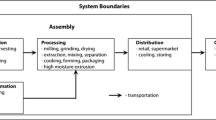Abstract
The aim of present study was to assess the correlation between the method of treating the carcasses of shot wild ducks (Anas platyrhynchos) and the formation of biogenic amines in the their muscles. The carcasses of wild ducks (n = 180) were divided into three groups of 60 carcasses according to the method of treatment: eviscerated, drawn, and left untreated. Each group was further divided into three subgroups of 20 duck carcasses on the basis of the storage temperature (0, 7, and 15 °C) and stored for 21 days. Samples of breast and thigh muscles were taken at regular weekly intervals. Biogenic amines (cadaverine, putrescine, tyramine, histamine, phenylethylamine, and tryptamine) in samples of breast and thigh muscles were separated by reverse-phase liquid chromatography and detected by tandem mass spectrometry. The sum of biogenic amines was compared with a value of 5 mg/kg, indicating the critical content for fresh meat of high hygienic quality. The results of this study indicated that the sum of biogenic amines in wild duck meat exceeded this limit in an extremely short period of time after the commencement of storage (during the first week of storage). Higher content of biogenic amines were recorded in thigh muscle compared to breast muscle of drawn ducks and untreated ducks. According to our results, the generally recommended method for treating the carcasses of feathered game after hunting (evisceration) does not represent a method that would ensure a longer period of freshness or higher hygiene quality of the game than the other two possible methods of treatment from the biogenic amines point of view.



Similar content being viewed by others
References
Atanassova V, Apelt J, Reich F, Klein G (2008) Microbiological quality of freshly shot game in Germany. Meat Sci 78:414–419
Balamatsia CC, Paleologos EK, Kontominas MG, Sayvaidis IN (2006) Correlation between microbial flora, sensory changes and biogenic amines formation in fresh chicken meat stored aerobically or under modified atmosphere packing at 4 °C: possible role of biogenic amines as spoilage indicators. Anton Leeuw 89:9–17
Boka B, Adanyi N, Virag D, Sebela M, Kiss A (2012) Spoilage detection with biogenic amine biosensor of different enzyme electrodes. Electroanal 24:181–186
El-Ghareeb WR, Smulders FJR, Morshdy AMA, Winkelmayer R, Paulsen P (2009) Microbiological condition and shelf life of meat from hunted game birds. Eur J Wildl Res 55:317–323
European Commission (2004) Regulation (EC) no. 853/2004 of the European Parliament and of the Council of 29 April 2004 laying down specific hygiene rules for on the hygiene of foodstuffs. Off J Eur Union L 39:55
Favaro G, Pastore P, Saccani G, Cavalli S (2007) Determination of biogenic amines in fresh and processed meat by ion chromatography and integrated pulsed amperometric detection on Au electrode. Food Chem 105:1652–1658
Gill CO (2007) Microbiological conditions of meats from large game animals and birds. Meat Sci 77:149–160
Hernandez-Jover T, Izquierdo-Pulido M, Veciana-Nogues MT, Vidal-Carou MC (1996) Biogenic amine sources in cooked cured shoulder pork. J Agr Food Chem 44:3097–3101
Hofbauer P, Smulders FJM, Vodnansky M, Paulsen P, El-Ghareeb WR (2010) A note on meat quality traits of pheasant (Phasianus colchicus). Eur J Wildl Res 56:809–813
Kaniou I, Samouris G, Mouratidou T, Eleftheriadou A, Zantopoulos N (2001) Determination of biogenic amines in fresh unpacked and vacuum-packed beef during storage at 4 °C. Food Chem 74:515–519
Kozova M, Kalac P, Pelikanova T (2009) Contents of biologically active polyamines in chicken meat, liver, heart and skin after slaughter and their changes during meat storage and cooking. Food Chem 116:419–425
Krausova P, Kalac P, Krizek M, Pelikanova T (2006) Content of polyamines in beef and pork after animal slaughtering. Eur Food Res Tech 223:321–324
Lecocq Y (1997) A European perspective on wild game meat and public health. Rev Sci Tech Off Int Epiz 16:579–585
Naila A, Flint S, Fletcher G, Bremer P, Meerdink G (2010) Control of biogenic amines in food-existing and emerging approaches. J Food Sci 75:139–150
Paulsen P, Nagy J, Popelka P, Ledecky V et al (2008) Influence of storage conditions and shotshell wounding on the hygienic condition of hunted, uneviscerated pheasant (Phasianus colchicus). Poult Sci 87:191–195
Paulsen P, Smulders FJM, Hilbert F (2012) Salmonella in meat from hunted game: a central European perspective. Food Res Int 45:609–616
Saccani G, Tanzi E, Pastore P, Cavalli S, Rey M (2005) Determination of biogenic amines in fresh and processed meat by suppressed ion chromatography-mass spectrometry using a cation-exchange column. J Chromatogr A 1082:43–50
Silva CMG, Gloria BA (2002) Bioactive amines in chicken breast and thigh after slaughter and during storage at 4 ± 1 °C and chicken-based meat products. Food Chem 78:241–248
Standarova E, Vorlova L, Gallas L (2012) Distribution of biogenic amines and polyamines in the pheasant meat. Maso 1:51–54
Winkelmayer R, Lebersorger P, Zedka HF (2004) Wildbret-Hygiene: Das Buch zur Wildfleisch-Verordnung, Zentralstelle Osterr. Landesjagdverbände, Wien
Zar JH (1999) Biostatistical analysis, 4th edn. Prentice Hall, Upper Saddle River
Acknowledgments
This work was supported by the project “Central European Institute of Technology (CEITEC)” (CZ.1.05/1.1.00/02.0068) from the European Regional Development Fund and the project IGA 93/2011/FVHE.
Author information
Authors and Affiliations
Corresponding author
Additional information
Communicated by C. Gortázar
Rights and permissions
About this article
Cite this article
Hutarova, Z., Forejtek, P., Vecerek, V. et al. The effect of treating method of game on the content of biogenic amines in wild duck (Anas platyrhynchos) meat during the course of storage. Eur J Wildl Res 60, 259–264 (2014). https://doi.org/10.1007/s10344-013-0775-y
Received:
Revised:
Accepted:
Published:
Issue Date:
DOI: https://doi.org/10.1007/s10344-013-0775-y




